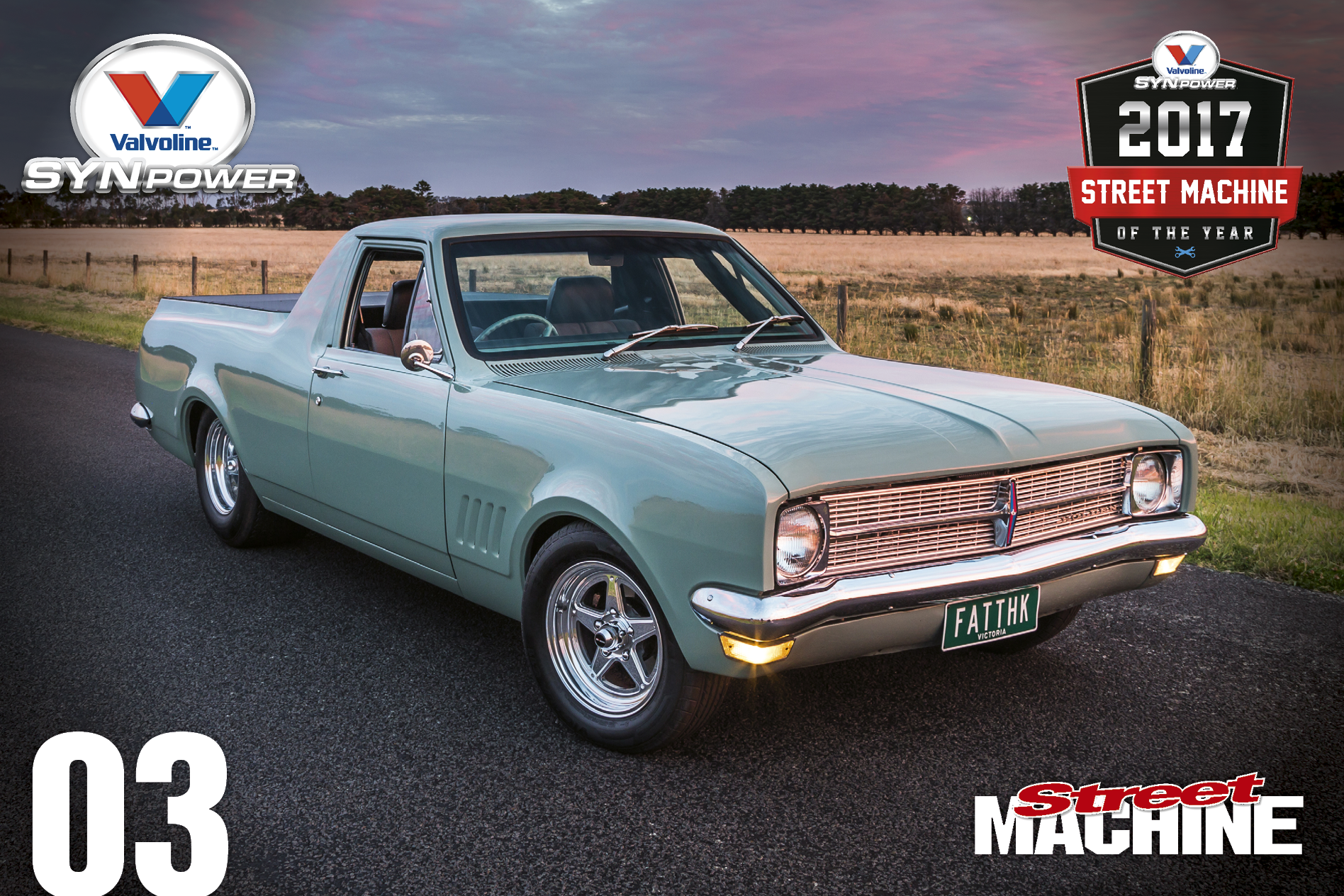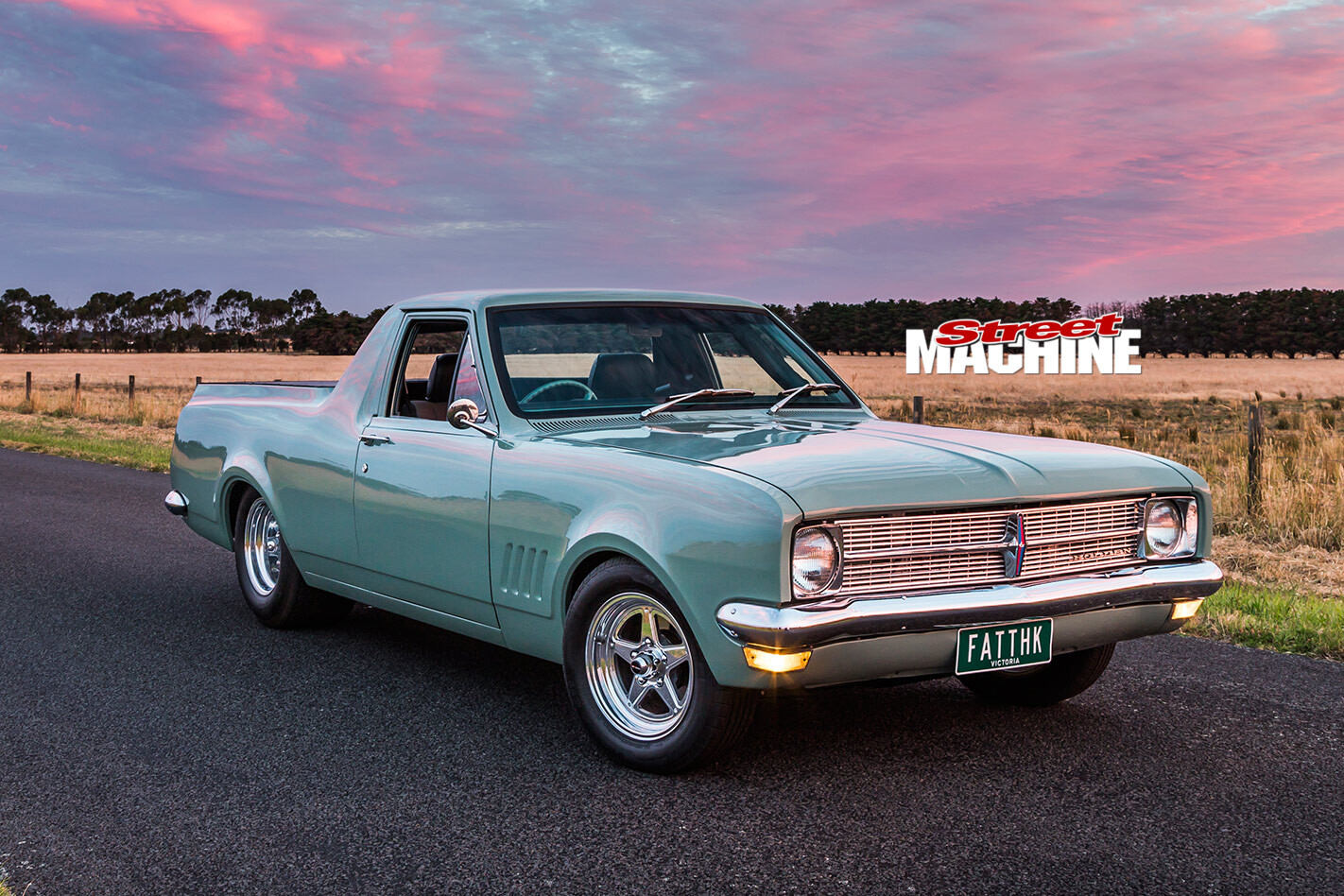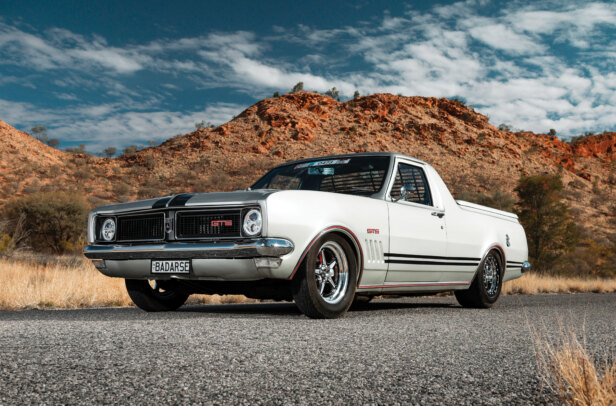ANY way you look at it, Luke Kestle’s 1970 Holden Belmont ute is bad-arse. You’ll go a long way to find a street car more focused on getting from point A to point B as quickly as possible. And it has the scalps to prove it, having won some prestigious small-tyre trophies like Radial Riot 275 champion and 2018 Kenda Radial main event runner-up, among others.
This article was first published in Street Machine’s 2020 Yearbook. Photos: Steve Kelly & Dave Reid
Luke prefers to leave the rear gears in the ute alone, sticking with 3.2:1 gearing for both eighth- and quarter-mile racing at all tracks. Rear tyre of choice for no-prep is a 28×10.5 slick and for radial racing a 275/60R15
Like so many successful racers, Luke has surrounded himself with some clever people to get everything in this hay hauler ironed out, thus far running a 7.80 at an incredible 176mph with a tough 383-cube small-block Chevy boosted by a massive 94mm Garrett GTX5533R turbo.
“I bought the car from my cousin a long time ago,” says Luke. “It’s been in the family for 20 years. It was a clean old thing, and back then I built it into a pretty mild 350-powered streeter.
“Later on I wanted to build the car to run in the X275 class, which meant a new 363ci motor with a big BorgWarner turbo. Back then the class rules dictated a cast 80mm turbo and it was a budget class.”
“Around four years ago, there were not many cars like this that made it into the 7s, so it was pretty ‘wow’ for me, especially because it’s nothing fancy: 23-degree heads, no fire rings, standard front crossmember and bolt-in suspension,” Luke says
Even though the X275 class had an 8.50 index, the ute broke out to the sweet tune of 8.20@162mph. Luke rightly started thinking it could run a seven – a big deal five years ago for what was pretty much a street car – so he stepped things up again.
“I decided to take on the radial racing and chatted to ‘Barefoot’ Bluey and Michael Arnold about an engine combination,” he says. “Five years later, that little motor just keeps on cranking, even with the same valve springs!”
The 383 uses some pretty good parts, with a Dart Little M block, Callies DragonSlayer crank, Oliver rods with tool-steel pins, L19 rod bolts and a 9.5:1 static compression ratio with 23-degree Dart PRO1 heads CNC-ported by Matt McCarthy.
Even though this engine sees over 40lb of boost, it’s got a set of eBay-special head studs that have not budged, even without fire rings in the block. The cam is some secret-squirrel, Arnold brothers solid-roller that is clearly doing its job.
Incredibly, Luke is buzzing this deal to 8900rpm year after year, which is testament to the build quality of the engine and his tuning capabilities.
“The best move I ever made was going from a blow-through carby to putting a Haltech 2500 ECU on the car,” says Luke. “I run EGTs and a number of other sensors. Once I learnt how to tune the thing myself, I stopped hurting parts, and it’s been a dream run ever since.”
The HG has been close to bulletproof going rounds at the track, which may be attributed to the less-than-traditional approach taken to some areas of its set-up.
“One of the things I love about this car is just how reliable it is; it just goes laps and I don’t touch it,” Luke says. “There are lots of quirky things about it, like the oil pressure, which is 60psi at idle thanks to the high-volume big-block pump, and on a pass it sees well over 100psi with a 40-weight oil. I know it’s not ideal, but it all just works. The bearings come out of it looking mint, so I just leave it.”
Things are similarly quirky on the hot side. “I run the Gen 1 turbo with twin 60mm Tial ’gates, but I run an extra 50mm on the intake through a four-port so I can hold the car at 8psi on the line for as long as I want without the use of CO2,” Luke explains.
The biggest issue with the car is its 1¾-inch primaries into a 2.5-inch merge pipe set-up, which worked for the five-years-ago combo but is now producing almost 80psi of back pressure at full noise.
“I tried a 150-shot of nitrous in the top end to cool the motor, but it actually made the problem worse due to the excessive back pressure,” says Luke. “I had a 1.4 rear housing made for the turbo, but it seems those early GTX55s have a small wheel with a weird pitch, so they work well on something like a 2J but are not a good fit for this combination. I need to change those pipes, but it won’t happen in this car.”
An ATI balancer and mandrel runs a belt-driven Enderle 110 alcohol pump, drawing from an 18-litre header tank to an Aeromotive regulator and eight 700lb Billet Atomizer injectors.
On just over 40lb of boost, the engine is showing 1600hp at the flywheel, and at a full race weight of 3440lb, the car runs in the low 1.3sec range in the 60ft and has run 5.15sec over the eighth-mile.
Other go-fast bits include the Haltech Elite 2500 and eight Haltech Smart Coils, although it’s notable that it went 7.90sec on 34lb of boost on stock LS1 coils.
All of the racing Luke does is without a speed sensor, so he doesn’t use any traction control (power management). Unlike a lot of big-power EFI deals, he likes to tune to the track rather than let the computer handle it.
“I’m dead against traction control,” he says. “I know it’s the future for fast racing, but I won’t do it.”
Backing up the mega-mill is a BTE Powerglide with a 1.80 gearset, 10-clutch top-gear drum and a bunch of other goodies supplied by American Auto Parts. Down the back, the suspension is all bolt-in gear from MotorFab, with a braced and shortened nine-inch housing and a bolt-through Strange Ultra Case by Western Suburbs Differentials.
“I still think of the ute as a street car, so I’m proud of the fact that it’s been in a couple of Kenda finals, beating cars that are faster and really just designated race cars,” says Luke. “It shows what you can do on a limited budget and fine-tuning.”
Big shout-out to Luke’s team of helpers, including ‘Barefoot’ Bluey and Mick Arnold; Marvin Bridge, who wired the car and has done a lot of hours on it; Michael Gibson, Luke’s one and only crew member; and Doug Day from RLC Engine Reconditioning.
“I think the car has a 7.50 in it, so we’ll keep chipping away,” Luke says. “I’d love to do Drag Challenge one day; it’s certainly one of the events we have built it for. I just need the time to get it done.”



Comments